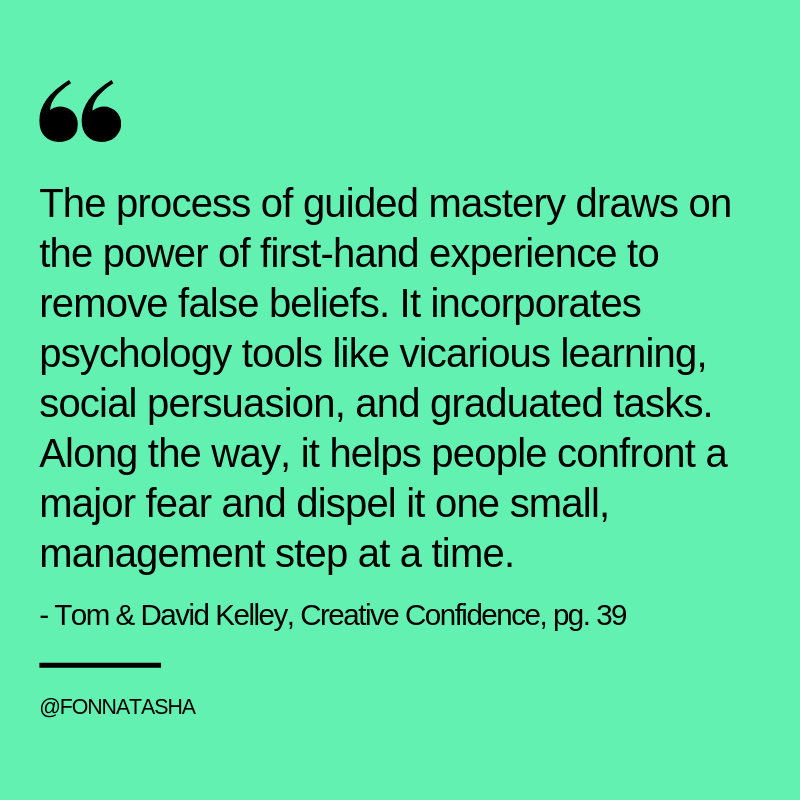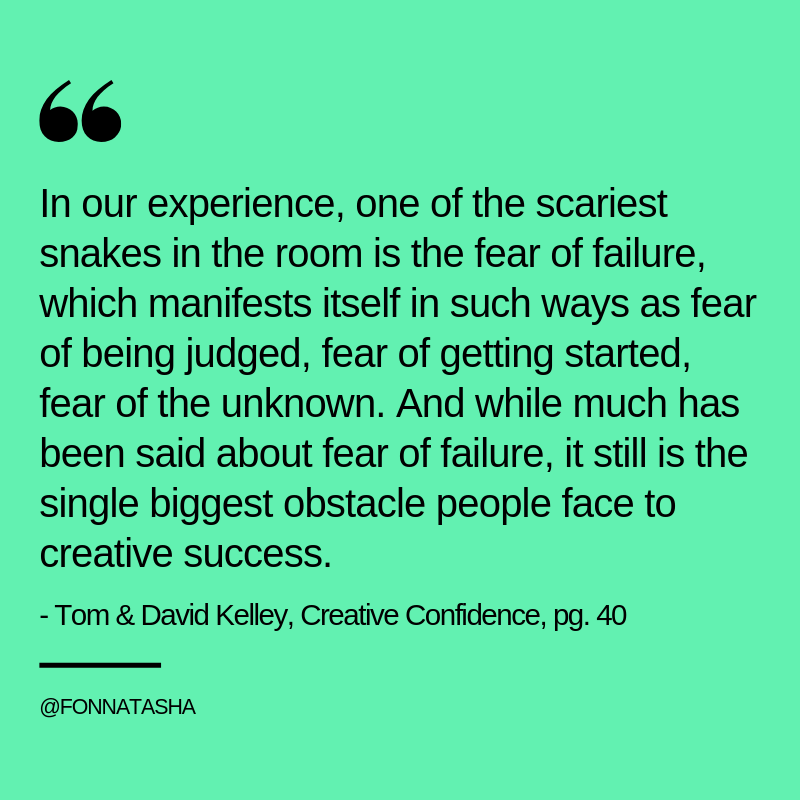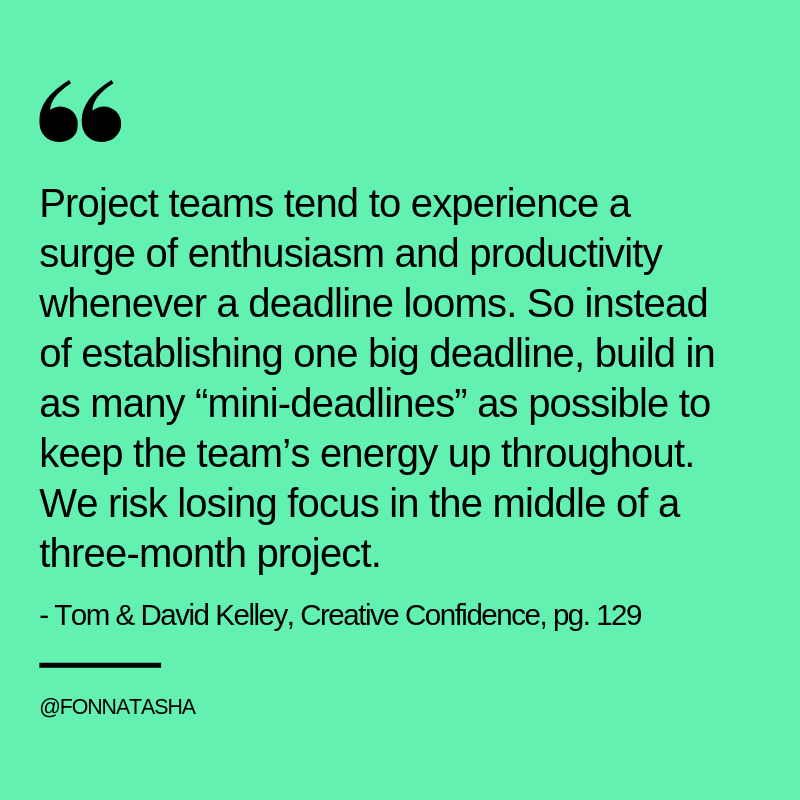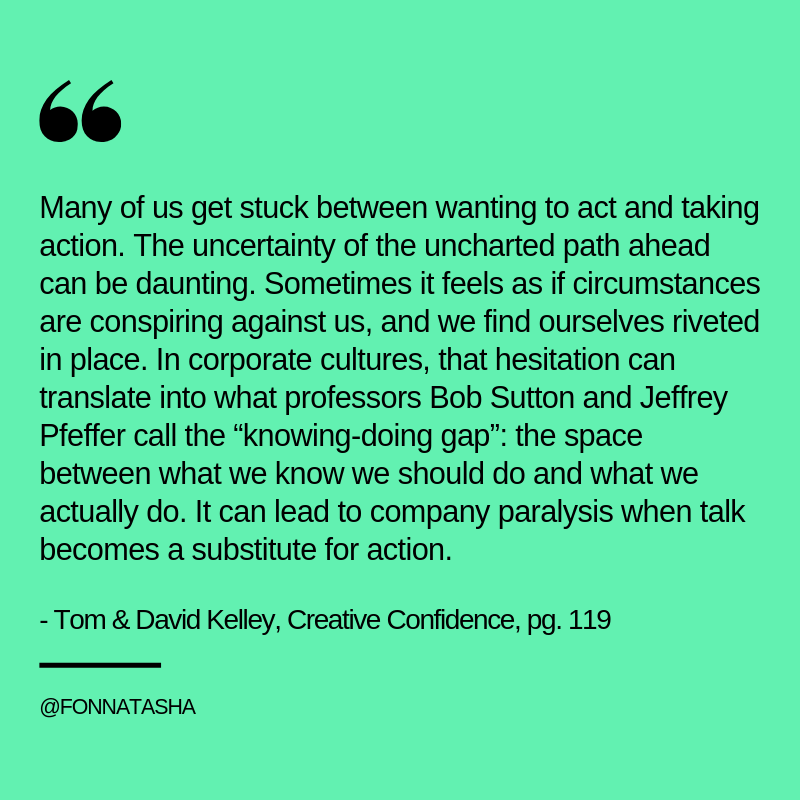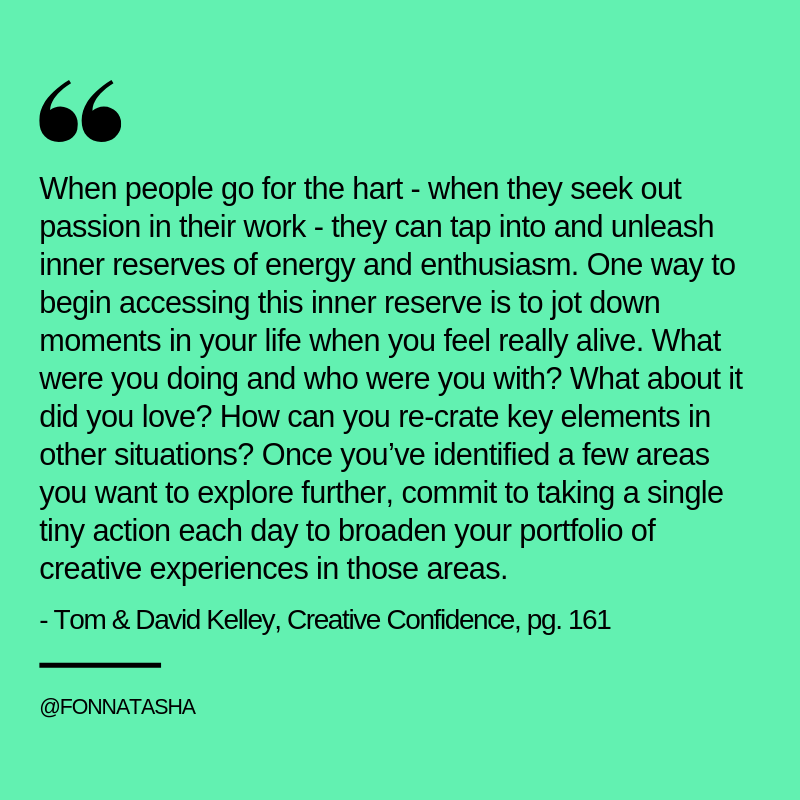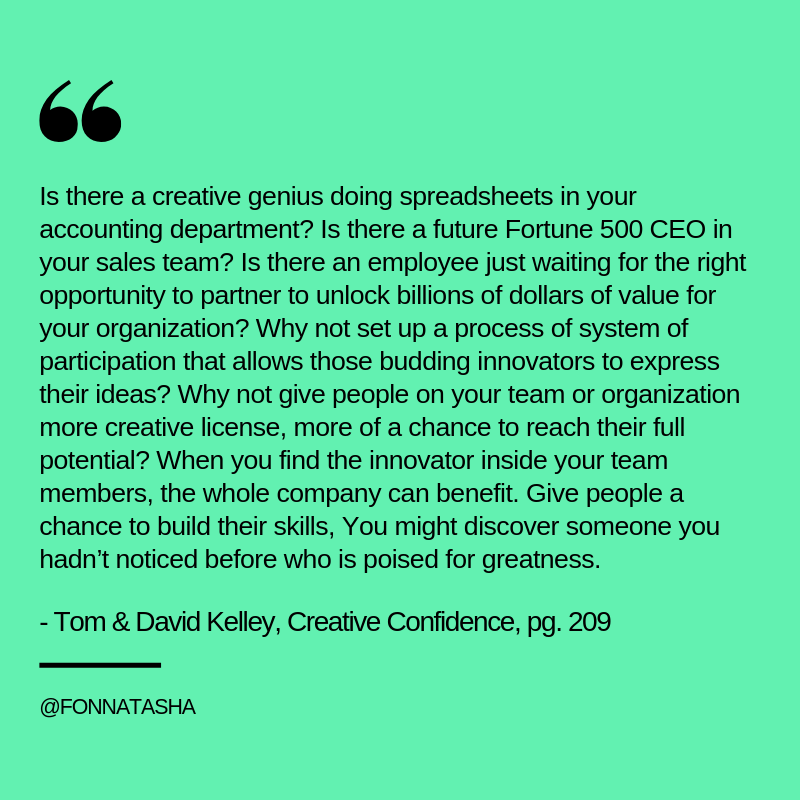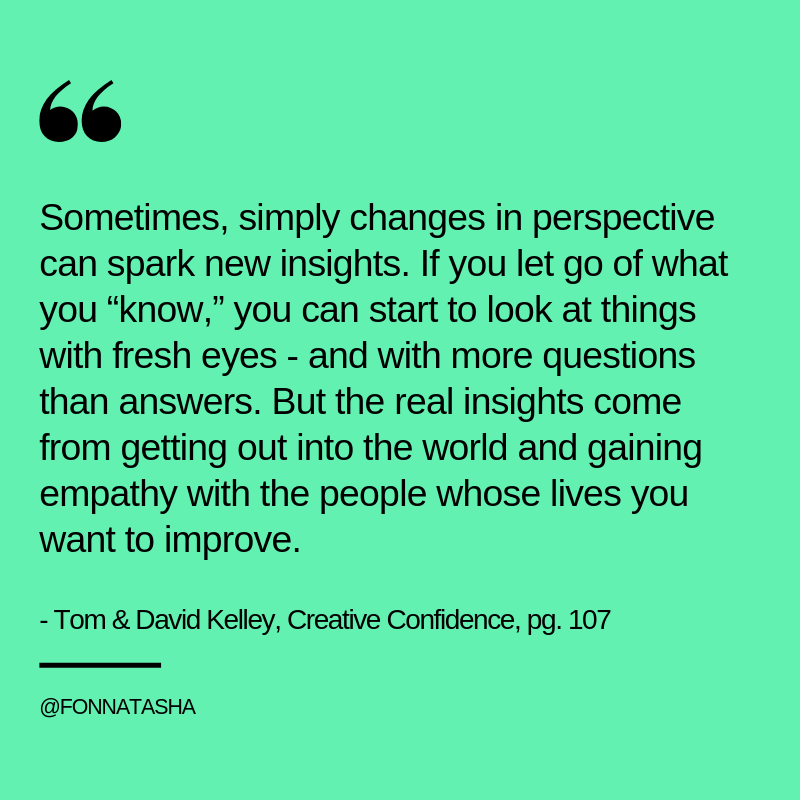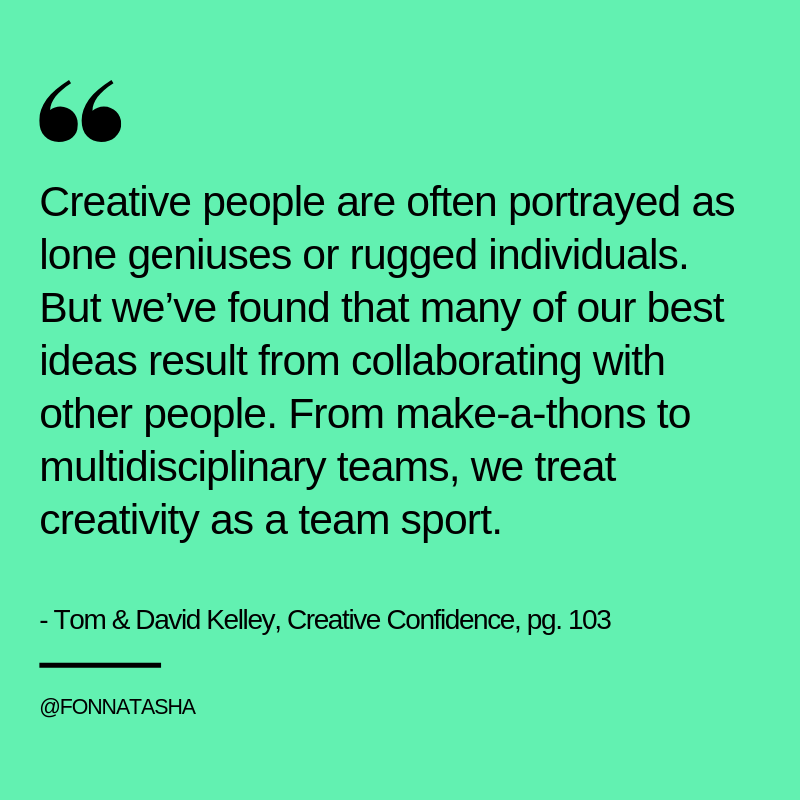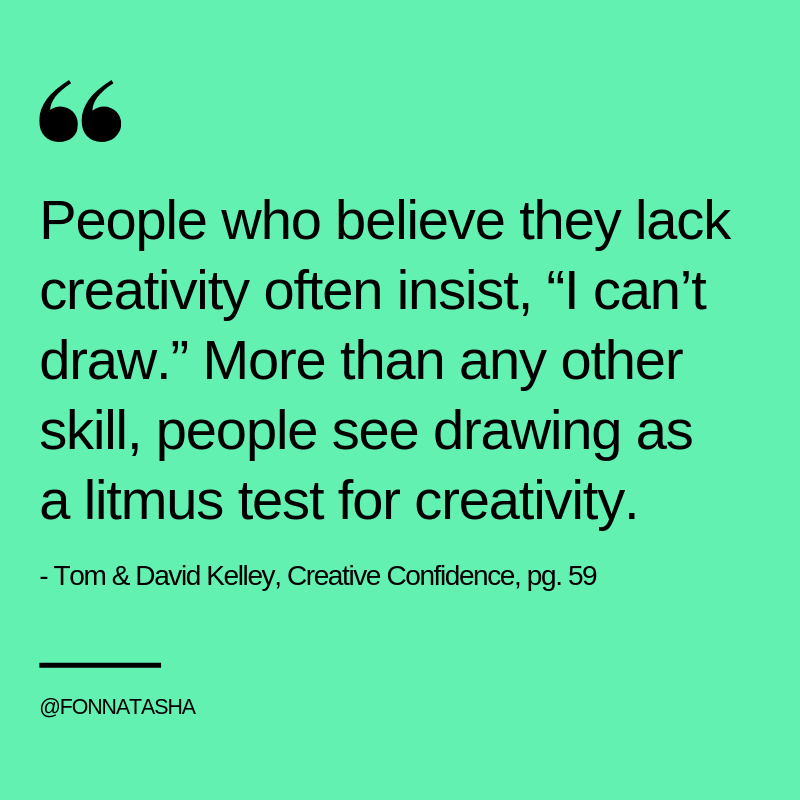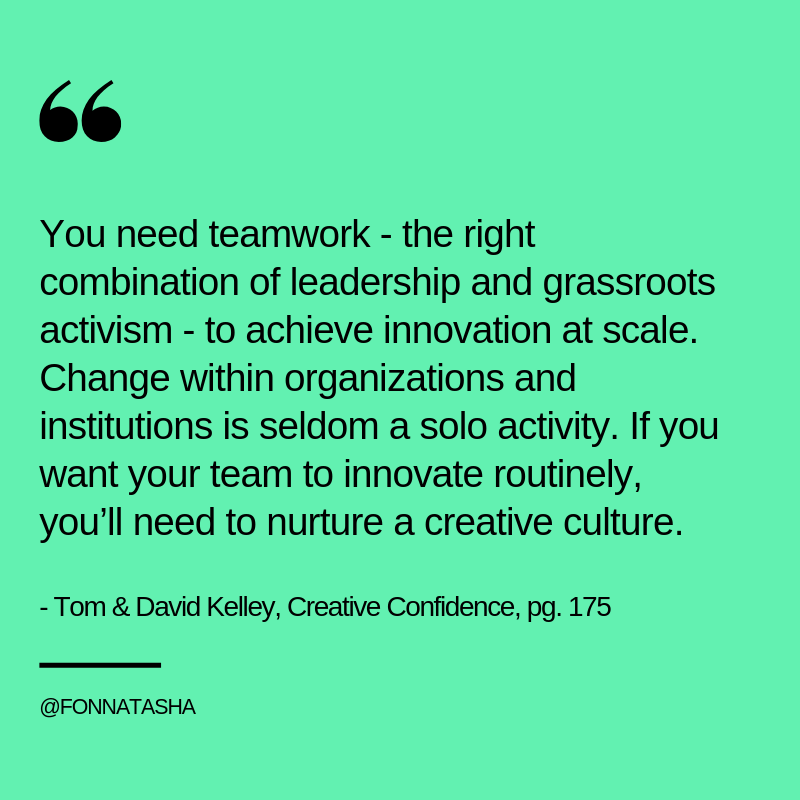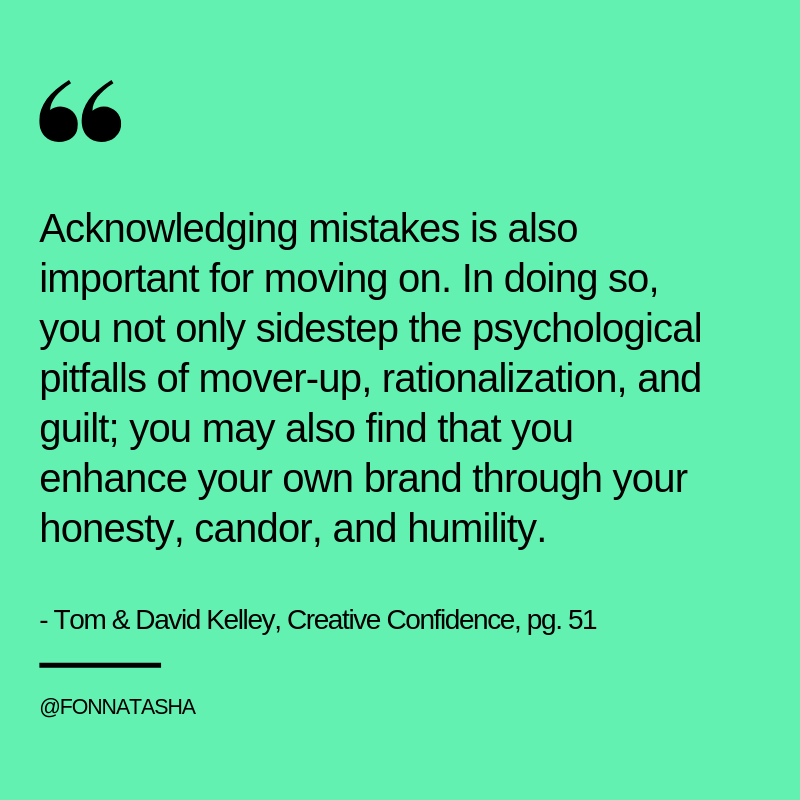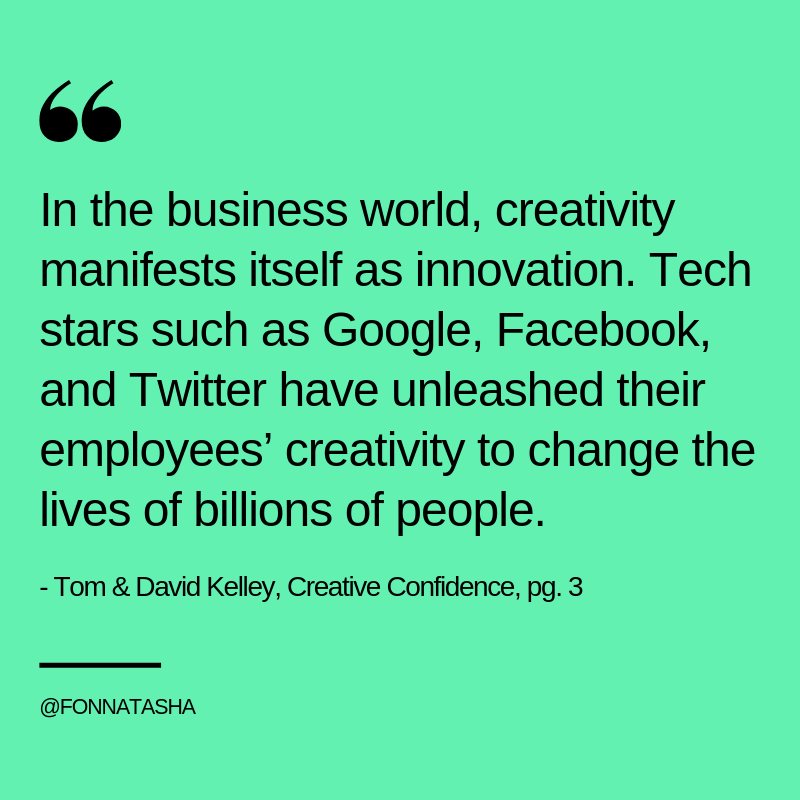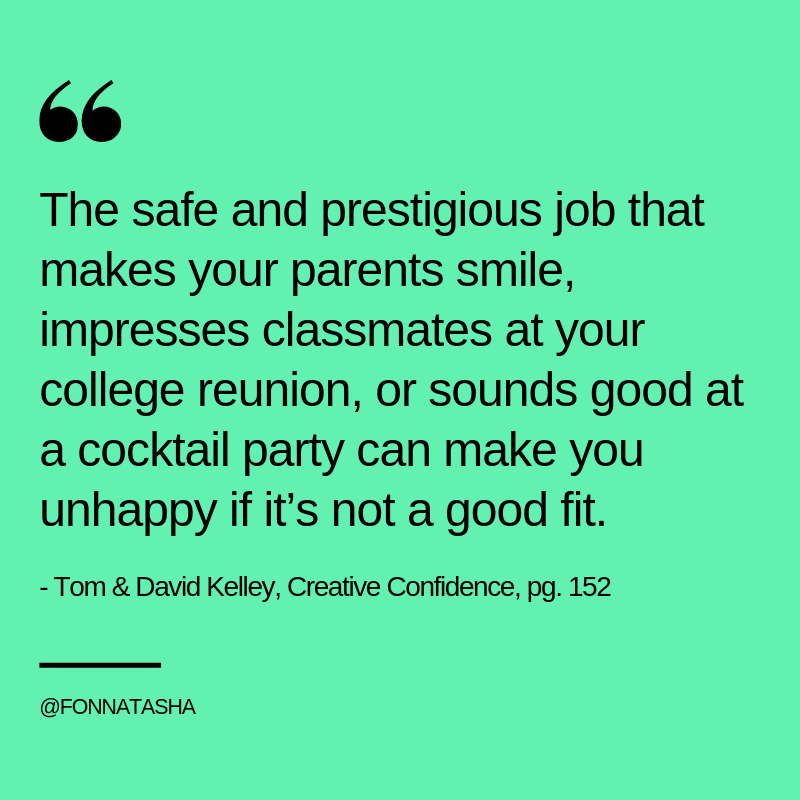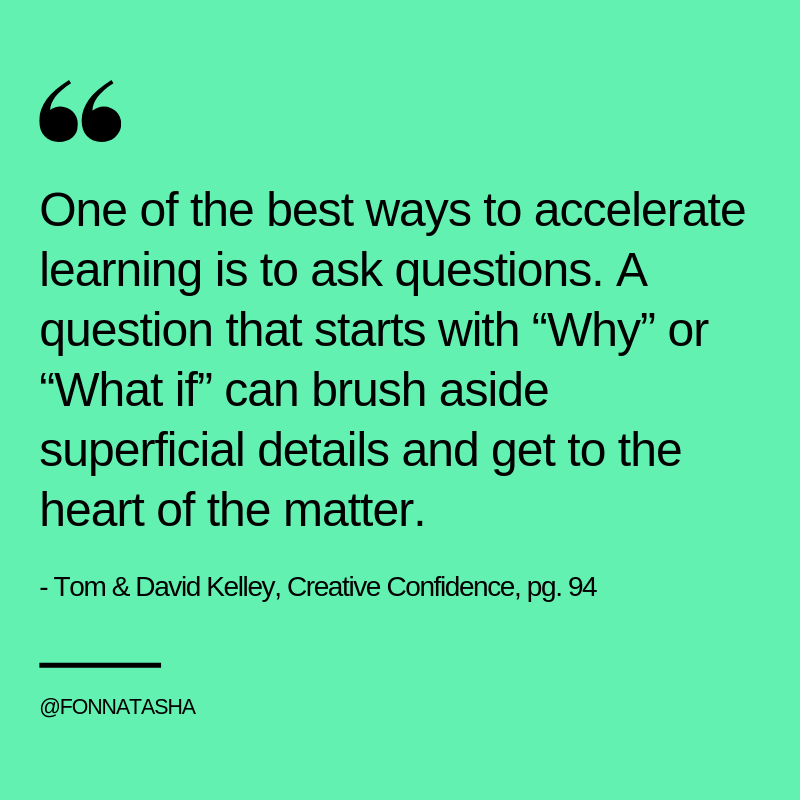I knew about design thinking before, but I never really applied the principles to my work life or creative practice. This book opened my eyes to the way creativity can be weaved into multiple aspects of our lives. It also helped my flip the script on stereotypes and limiting thoughts I had about creative people. Here’s one of my favourite quotes from the book:
You don’t have to switch careers or move to Silicon Valley to change your mindset. You don’t have to become a design consultant or quit your job. The world needs more creative policy makers, office managers, and real estate agents. Whatever your profession, when you approach it with creativity, you’ll come up with new and better solutions and more successes. - Tom Kelley & David Kelley, Creative Confidence, p. 9
Check out 70+ quotes from the book below:
When you hear the word “creativity,” what do you think of next?
If you are like many people, your mind immediately leaps to artistic endeavors like sculpture, drawing, music, or dance.
You may equate “creative” with “artistic”.
You may believe that architects and designers are paid to be creative thinkers, but CEOs, lawyers, and doctors are not.
Or you may feel that being creative is a fixed trait, like having brown eyes -either you’re born with creative genes, or you’re not.
As brothers who have worked together for thirty years at the forefront of innovation, we have come to see this set of misconceptions as “the creativity myth.” It is a myth that far too many people share. This book is about the opposite of that myth. It is about what we call “creative confidence.” And at its foundation is the belief that we are all creative. The truth is, we all have far more creative potential waiting to be tapped. - Tom Kelley & David Kelley, Creative Confidence, p. 1At its core, creative confidence is about believing in your ability to create change in the world around you. It is the conviction that you can achieve what you set out to do. We think this self-assurance, this belief in your creative capacity, lies at the heart of innovation. - Tom Kelley & David Kelley, Creative Confidence, p. 2
Creativity is much broader and more universal than what people typically consider the “artistic” fields. We think of creativity as using your imagination to create something new in the world. Creativity comes into play wherever you have the opportunity to generate new ideas, solutions, or approaches. And we believe everyone should have access to that resource. - Tom Kelley & David Kelley, Creative Confidence, p. 3
Whether you live in Silicon Valley or Shanghai, Munich or Mumbai, you’ve already felt the effects of seismic market shifts. Most businesses today realize that the key to growth, and even survival, is innovation. - Tom Kelley & David Kelley, Creative Confidence, p. 4
What we’ve found is that we don’t have to generate creativity from scratch. We just need to help people rediscover what they already have: the capacity to imagine - or build upon - new-to-the-world ideas. But the real value of creativity doesn’t emerge until you are brave enough to act on those ideas. That combination of thought and action defines creative confidence: the ability to come up with new ideas and the courage to try them out. - Tom Kelley & David Kelley, Creative Confidence, p. 6
When people transcend the fears that block their creativity, all sorts of new possibilities emerge. Instead of being paralyzed by the prospect of failure, they see every experience as an opportunity they can learn from. The need for control keeps some people stuck at the planning stage of a project. With creative confidence, they become comfortable with uncertainty and are able to leap into action. - Tom Kelley & David Kelley, Creative Confidence, p. 10
A creative mindset can be a powerful force for looking beyond the status quo. - Tom Kelley & David Kelley, Creative Confidence, p. 18
Design thinking relies on the natural - and coachable - human ability to be intuitive, to recognize patterns, and to construct ideas that are emotionally meaningful as well as functional. - Tom Kelley & David Kelley, Creative Confidence, p. 25
If you have a problem that you can’t analyze easily, or that doesn’t have a metric or enough data to draw upon, design thinking may be able to help you move forward using empathy and prototyping. When you need to achieve a breakthrough innovation or make a creative leap, this methodology can help you dive into the problem and find new insights. - Tom Kelley & David Kelley, Creative Confidence, p. 25
One prerequisite for achieving creative confidence is the belief that your innovation skills and capabilities are not set in stone. If you currently feel that you are not a creative person - if you think, “I’m not good at that kind of thing” - you have to let go of that belief before you can move on. You have to believe that learning and growth are possible. In other words, you need to start with what Stanford psychology professor Carol Dweck calls a “growth mindset”. - Tom Kelley & David Kelley, Creative Confidence, p. 30
To fully appreciate the growth mindset, it helps to contrast it with its all-too-familiar evil twin, the fixed mindset have the deep-seated belief that everyone is born with only a certain amount of intelligence and a certain amount of talent. If invited on a journey to creative confidence, people with a fixed mindset will prefer to stay behind in their comfort zone, afraid that the limits of their capabilities will be revealed to others. - Tom Kelley & David Kelley, Creative Confidence, p. 31
...those under the influence of a fixed mindset were willing to sabotage their long-term chances for success rather than expose a potential weakness. If they let the same logic guide their choices throughout life, it’s easy to understand how their perception of their own abilities as permanently limited can become a self-fulfilling hypothesis. - Tom Kelley & David Kelley, Creative Confidence, p. 31
A growth mindset, on the other hand, is a passport to new adventures. - Tom Kelley & David Kelley, Creative Confidence, p. 31
In reality, we all have a little of both mindsets. Sometimes the fixed mindset whispers in one ear: “We’ve never been good at anything creative, so why embarrass ourselves now?” And the growth mindset whispers in the other ear: “Effort is the path to mastery, so let’s at least give this a try.” The question is, which voice are you going to listen to? - Tom Kelley & David Kelley, Creative Confidence, p. 32
When you unleash your creative confidence, you start to see new ways to improve on the status quo - from how you throw a dinner party to how you run a meeting. And once you become aware of those opportunities, you have to start seizing them. - Tom Kelley & David Kelley, Creative Confidence, p. 33
Steve Jobs was famous for his exhortation to “make a dent in the universe,” which he expressed this way in a 1994 interview:
“The minute that you understand that you can poke life and actually something will...pop out the other side, that you can change it, you can mold it, that’s maybe the most important thing...Once you learn that, you’ll never be the same again.
- Tom Kelley & David Kelley, Creative Confidence, p. 34The newfound courage, exhibited by the same people who once had to wear hockey masks to get near a snake, led Bandura to pivot toward a new line of research: how people come to believe that they can change a situation and accomplish what they set out to do in the world.
Since then, Bandura’s research has shown that when people have this belief, they undertake tougher challenges, persevere longer, and are more resilient in the face of obstacles and failure. Bandura calls this belief “self-efficacy.” - Tom Kelley & David Kelley, Creative Confidence, p. 39Bandura’s work scientifically validated something we’ve been seeing for years: Doubts in one’s creative ability can be cured by guiding people through a series of small successes. And the experience can have a powerful effect on the rest of their lives. The state of mind Bandura calls self-efficacy is closed related to what we think of as creative confidence. - Tom Kelley & David Kelley, Creative Confidence, p. 40
People who have creative confidence make better choices, set off more easily in new directions, and are better able to find solutions to seemingly intractable problems. They see new possibilities and collaborate with others to improve the situations around them. And they approach challenges with newfound courage.
But to gain this creative, empowered mindset, sometimes you have to touch the snake. - Tom Kelley & David Kelley, Creative Confidence, p. 40A widely held myth suggests that creative geniuses rarely fail. Yet according to Professor Dean Keith Simonton of the University of California, Davis, the opposite is actually true: creative geniuses, from artists like Mozart to scientists like Darwin, are quite prolific when it comes to failure - they just don’t let that step them. His research has found that creative people simply do more experiments. Their ultimate “strokes of genius” don’t come about because they succeed more often than other people - they just do more, period. They take more shots at the goal. That is the surprising, compelling mathematics of innovation: if you want more success, you have to be prepared to shrug off more failure. - Tom Kelley & David Kelley, Creative Confidence, p. 41
In fact, early failure can be crucial to success in innovation. Because the faster you find weaknesses during an innovation cycle, the faster you can improve what needs fixing. - Tom Kelley & David Kelley, Creative Confidence, p. 41
At the d.school, one of the goals of getting people to work together on a project is to help them practice new skills and challenge themselves - and most likely experience failure as a result. We believe the lessons learned from failures may make us smarter - even stronger. But that doesn’t make failure any more fun. So most of us naturally try to avoid failure at all costs. Failure is hard, even painful. As Stanford professor Bob Sutton and IDEO partner Diego Rodriguez often say at the d.school, “Failure sucks, but instructs.” - Tom Kelley & David Kelley, Creative Confidence, p. 43
In his book Juggling for the Complete Klutz, Cass didn’t start us out juggling two balls, or even one. He began with something more basic: “The Drop.” Step one is simply to throw all three balls in the air and let them drop. Then repeat. In learning to juggle, the angst comes from failure - from having the ball fall to the floor. So with step one, Cass aims to numb aspiring jugglers to that. Having the ball fall to the floor becomes more normal than the ball not falling to the floor. After we address our fear of failure, juggling becomes a lot easier. The two of us were skeptical at first, but with the help of his simple approach, we really did learn to juggle.” - Tom Kelley & David Kelley, Creative Confidence, p. 44
In the realm of video games, the level of challenge and reward rises proportionately with a gamer’s skills; moving forward always requires concentrated effort, but the next goal is never completely out of reach. This contributes to what Jane McGonigal calls “urgent optimism”: the desire to act immediately to tackle an obstacle, motivated by the belief that you have a reasonable hope of success. Gamers always believe that an “epic win” is possible - that it is worth trying, and trying now, over and over again. In the euphoria of an epic win, gamers are shocked to discover the extent of their capabilities. As you move from level to level, success can flip your mindset to a state of creative confidence. We’ve all seen this kind of persistence and gradual mastery of skills in children - from toddlers learning to walk to kids learning how to shoot a basketball. - Tom Kelley & David Kelley, Creative Confidence, p. 47
By adapting the best attributes of gaming culture, we can shift people’s view of failure and ratchet up their willingness and determination to persevere. We just need to hold out a “Reasonable hope for success”, as well as the possibility of a truly epic win. - Tom Kelley & David Kelley, Creative Confidence, p. 48
Diego Rodriguez in his blog Metacool says that innovation thinkers often use “informed intuition” to identify a great insight, a key need, or a core feature. In other words, relentless practice creates a database of experience that you can draw upon to make more enlightened choices. When it comes to bringing new stuff into the world, Diego argues that the number of product cycles you’ve gone through (what he calls “mileage”) trumps the number of years of experience. - Tom Kelley & David Kelley, Creative Confidence, p. 48-49
Whether you consider yourself a “born innovator” or are new to creative confidence, you can get better faster at coming up with new ideas if you give yourself and those around you the leeway to make mistakes from time to time. Permission to fail comes more easily in some settings than others. - Tom Kelley & David Kelley, Creative Confidence, p. 49
To learn from failure, however, you have to “own” it. You have to figure out what went wrong and what to do better next time. If you don’t, you’re liable to rpat your errors in the future. - Tom Kelley & David Kelley, Creative Confidence, p. 51
What’s refreshing and not so predictable is that one click away from these mega-successes is a catalog of miscues and failed foresight Bessemer Venture Partners calls their “Anti-Portfolio.” As Bessemer explains, their “long and storied history has afforded our firm an unparalleled number of opportunities to completely screw up.” One of their partners passed over a chance to invest in the Series A round of PayPal, which sold a few years later for $1.5 billion. The firm also passed - seven times - on the chance to invest in FedEx, currently worth over $30 billion. - Tom Kelley & David Kelley, Creative Confidence, p. 51-52
Author and educator Tina Seelig asks her students to write a “failure resume” that highlights their biggest defeats and screw-ups. She says that smart people accustomed to promoting their successes find it very challenging. In the process of compiling their failure resume, however, they come to own their setbacks, both emotionally and intellectually. - Tom Kelley & David Kelley, Creative Confidence, p. 52
One day, David and Brian were in art class, sitting at a table with half a dozen classmates. Brian was working on a sculpture, making a horse out of the clay that the teacher kept under the sink. Suddenly one of the girls saw what he was making, leaned over, and said to him, “That’s terrible. That doesn’t look anything like a horse.” Brian’s shoulders sank. Dejected, he wadded up the clay horse and throw it back in the bin. David never saw Brian attempt a creative project again.
How often does something like that happen in childhood? Whenever we mention lost-confidence stories like Brian’s to business audiences, someone always comes up to us afterward to share a similar experience when a teacher or parent or peer shut them down. Let’s face it, kids can be cruel to one another. Sometimes, people remember a specific moment when they decided, as children, that they weren’t creative. Rather than be judged, they simply withdrew. They stopped thinking of themselves as creative at all. - Tom Kelley & David Kelley, Creative Confidence, p. 54A “creativity scar,” a specific incident when they were told they weren’t talented as artists, musicians, writers, singers. - Tom Kelley & David Kelley, Creative Confidence, p. 55
The tendency to label ourselves as “noncreative” comes from more than just our fear of being judged. As schools cut funding for the arts and high-stakes testing becomes more pervasive, creativity itself is devalued, compared to traditional core subjects like math and science. Those subjects emphasize ways of thinking and problem solving that have a clear-cut single right answer, while many real-world twenty-first-century challenges require more open-minded approaches. - Tom Kelley & David Kelley, Creative Confidence, p. 55
“When our self-worth isn’t on the line, we are far more willing to be courageous and risk sharing our raw talents and gifts.” One way to embrace creativity, Brene Brown says, is to let go of comparison. If you are concerned about conforming or about how you measure up to others’ successes, you won’ perform the risk taking and trailblazing inherent in creative endeavors. - Tom Kelley & David Kelley, Creative Confidence, p. 57
Resilient people, in addition to being resourceful problem solvers, are more likely to seek help, have strong social support, and be better connected with colleagues, family, and friends. Resilience is often thought of as a solo effort - the lone hero who falls and rises up again to do battle. In reality, however, reaching out to others is usually a strategy for success. It doesn’t have to be an admission of weakness. We need others to help us bounce back from adversity and hardship. - Tom Kelley & David Kelley, Creative Confidence, p. 58
But innovation - whether driven by an individual or a team - can happen anywhere. It’s fueled by a restless intellectual curiosity, deep optimism, the ability to accept repeated failure as the price of ultimate success, a relentless work ethic, and a mindset that encourages not just ideas, but action. - Tom Kelley & David Kelley, Creative Confidence, p. 74
Ever travel to a foreign city? We’ve all heard that “travel broadens the mind.” But beneath this cliche lies a deep truth. Things stand out because they’re different, so we notice every detail, from street signs to mailboxes to how you pay at a restaurant. We learn a lot when we travel not because we are any smarter on the road, but because we pay such close attention. - Tom Kelley & David Kelley, Creative Confidence, p. 77
Try to engage a “beginner’s mind.” For kids, everything is novel, so they ask lots of questions and look at the world wide-eyed, soaking it all in. Everywhere they turn, they tend to think, “Isn’t that interesting?” rather than “I already know about that.” - Tom Kelley & David Kelley, Creative Confidence, p. 78
Rediscovering the familiar is a powerful example of how looking at something closely can affect what you see. So apply a beginner’s mind to something you do or see every day: commuting to work, eating dinner, or preparing for a meeting. Look for new insights about familiar things. Think of it as a treasure hunt. - Tom Kelley & David Kelley, Creative Confidence, p. 78
By adopting the eyes of a traveler and a beginner’s mindset, you will notice a lot of details that you normally might have overlooked. You put aside assumptions and are fully immersed in the world around you. In this receptive mode, you’re ready to start actively searching out inspiration. And when it comes to inspiration, quantity matters. - Tom Kelley & David Kelley, Creative Confidence, p. 79
The more fresh new ideas cross your field of vision each day, the greater your insights will be. As Nobel laureate Linus Pauling famously said, “If you want a good idea, start with a lot of ideas.” At IDEO, we try to keep a fast-running stream of conversations going about provocative new technologies, inspiring case studies, and emerging trends. - Tom Kelley & David Kelley, Creative Confidence, p. 79
Ask yourself, what can you do to increase your “deal flow” of new ideas? When was the last time you took a class? Read some unusual magazines or blogs? Listened to new kinds of music? Traveled a different route to work? Had coffee with a friend or colleague who can teach you something new? Connected to “big ideas” people via social media?
To keep your thinking fresh, constantly seek out new sources of information. - Tom Kelley & David Kelley, Creative Confidence, p. 81So he took the extraordinary step of asking a Ferrari pit crew to coach staff members.
The doctors and nurses translated the pit crew’s techniques into new behaviours. For example, they now map out tasks and timing for every role in order to minimize the need for conversation. And they step through a checklist to relay key patient information. As reported in the Wall street Journal, the Ferrari- inspired changes reduced technical errors by 42% and information errors by 49%. - Tom Kelley & David Kelley, Creative Confidence, p. 82A wandering mind can be a good thing. Researcher Jonathan Schooler of the University of California, santa Barbara, believes that our brains are often working on “task-unrelated” ideas and solutions when we daydream. That could explain studies showing that prolific mind wanderers score higher on tests of creativity. And new research on the network of the brain similarly found that our minds make unlikely connections between ideas, memories, and experiences when we are at rest and not focused on a specific task or project. - Tom Kelley & David Kelley, Creative Confidence, p. 83
Relaxed attention lies between meditation, where you completely clear your mind, and the laserlike focus you apply when tackling a tough math problem. Our brains can make cognitive leaps when we are not completely obsessed with a challenge, which is why good ideas sometimes come to us while we are in the shower, or taking a walk or a long drive. - Tom Kelley & David Kelley, Creative Confidence, p. 83
The notion of empathy and human-centeredness is still not widely practiced in many corporations. Business people rarely navigate their own websites or watch how people use their products in a real-world setting. And if you do a word association with “business person,” the word “empathy” doesn’t come up much. - Tom Kelley & David Kelley, Creative Confidence, p. 85
As the American writer Mark Twain said a century ago, “It’s not what you don’t know that gets you into trouble, it’s what you know for sure that ain’t so.” Don’t be fooled by what you “know for sure” about your customer, yourself, your business, or the world. Seek out opportunities to observe and update your worldview.” - Tom Kelley & David Kelley, Creative Confidence, p. 94
Think about how you approach clients or customers. Do you ask deep, probing questions, or are you hearing what you expect? Are you making a connection or just making contact?
Coe Leta Stafford, a veteran IDEO design researcher with a PhD in cognitive development, has lots of experience asking questions of potential end users. One way she brings questions to life is by making them playful. Instead of asking “Why do you like this book so much?” she’ll turn it into a game: “Pretend you wanted to convince a friend that they should read this book, what would you tell them?” She reframes the question in a way that sidesteps some of the “business as usual” responses and elicits more meaningful answers. - Tom Kelley & David Kelley, Creative Confidence, p. 96At IDEO’s Munich office, we call the reframed challenge “Question Zero,” since it is a new starting point for seeking creative solutions. Reframing the problem not only gives you more successful solutions but also allows you to address brigger, more important problems. - Tom Kelley & David Kelley, Creative Confidence, p. 100
Successful scientists must have been extremely susceptible to such happy accidents because there are dozens of such stories in the history of science and invention. From penicillin to pacemakers, and from saccharin to safety glass, a lot of discoveries have come into this world because scientists noticed that one of their mishaps or mistakes had turned into a breakthrough. Their success-from-failure stories indicate not only that they were keen observers, but also that they were conducting a lot of experiments to begin with. - Tom Kelley & David Kelley, Creative Confidence, p. 106
To overcome inertia, good ideas are not enough. Careful planning is not enough. The organizations, communities, and nations that thrive are the ones that initiate action, that launch rapid innovation cycles, that learn by doing as soon as they can. They are sprinting forward, while others are still waiting at the starting line. - Tom Kelley & David Kelley, Creative Confidence, p. 115
While the path of least resistance is usually to coast along in neutral, people with creative confidence have a “do something” mindset. They believe their actions can make a positive difference, so they act. They recognize that waiting for a perfect plan or forecast might take forever, so they move forward, knowing they will not always be right but optimistic about their ability to experiment and conduct midcourse corrections further down the road. - Tom Kelley & David Kelley, Creative Confidence, p. 116
No company that falls behind the competition is guilty of standing completely still. But sometimes our efforts fail because of the level of commitment to change. “I’ll try” can become a halfhearted promise of follow-through rather than decisive action. - Tom Kelley & David Kelley, Creative Confidence, p. 120
If you want to make something great, you need to start making. Striving for perfection can get in the way during the early stages of the creative process. So don’t get stuck at the planning stage. Don’t let your inner perfectionist slow you down. All the overplanning, all the procrastinating, and all the talking are signs that we are afraid, that we just don’t feel ready. You want everything to be “just right” before you commit further or share something with others. That tendency leads us to wait rather than act, to perfect rather than launch. - Tom Kelley & David Kelley, Creative Confidence, p. 123
Pressfield's sleight of hand, substituting the word “resistance” for “procrastination,” is more than just semantics. In giving the phenomenon a different name, PRessfield redefines that enemy. Procrastination seems like a form of personal weakness. But Resistance is a force we can do battle with. Mentioning procrastination is a reminder of our failings. But invoking Resistance is a call to arms. It’s an obstacle we are challenged to overcome. - Tom Kelley & David Kelley, Creative Confidence, p. 124
As IDEO design director Tom Hulme puts it, “Release your idea into the wild before it’s ready.” Real-world market testing (even when you know you have more development to do) can be an invaluable source of insight. - Tom Kelley & David Kelley, Creative Confidence, p. 143
Try recasting your changes as experiments to boost reception and increase creative confidence. Some will fail (that’s why it’s called “trial and error”). But many, protected under the non threatening umbrella of experimentation, may raise your chances of success. - Tom Kelley & David Kelley, Creative Confidence, p. 146
Like too many of us, Jeremy found himself trapped by the “curse of competence.” Yes, he could successfully perform all the requirements of his job, but he gained no real fulfillment from what he did. Raised with a tireless work ethic, Jeremy showed up at the office everyday, “resigned to the fact that I would hate whatever I did for the next twenty years.” - Tom Kelley & David Kelley, Creative Confidence, p. 153
And that’s the point. Work doesn’t have to feel like “Work with a capital W.” You should be able to feel passion, purpose, and meaning in whatever you do. And that shift in perspective can open up a world of possibilities. - Tom Kelley & David Kelley, Creative Confidence, p. 154
The “looks good, feel bad” trap is all about avoiding a career that makes you feel unhappy - and finding the right fit in terms of your interests, skills, and values. - Tom Kelley & David Kelley, Creative Confidence, p. 155
Amy Wrzesniewski has found that people have one of three distinct attitudes toward the work they do: they think of it as either a job, a career, or a calling. And the difference is crucial. When work is strictly a job, it may effectively pay the bills, but you’re living mostly for the weekend and your hobbies. Those who see work as a career focus on a promotions and getting ahead, putting in long hours to achieve a more impressive title, a larger office, or a higher salary. In other words, you are focused on checking off achievements rather than pursuing deeper meaning. In contrast, for those who pursue a calling, their work is intrinsically rewarding in its own right - no just a means to an end. So, what you do professionally fulfills you personally as well. And often that work is meaningful because you are contributing to a larger purpose or feel part of a larger community. As Wrzesniewski points out, the origins of the word “calling: are religious, but it maintains its meaning in the secular context of work: the sense that you are contributing to a higher value or to something bigger than yourself. - Tom Kelley & David Kelley, Creative Confidence, p. 156
Erik smiles wryly as he remembers what he asked: “Isn’t it wonderful now that you have made it as professional musician that you don’t have to practice anymore?”
The question hung in the air for a moment before Yo-Yo Ma delivered the bad news to Erik. Long after ascending to the top of his field, Yo-Yo Ma continues to practice as much as six hours a day. Erik was crushed. But Yo-Yo Ma’s lesson is a reminder to us all - passion doesn’t preclude effort. In fact, passion demands effort. But in the end, you are more likely to feel that all that effort was worthwhile. - Tom Kelley & David Kelley, Creative Confidence, p. 158Jim Collins began by drawing a Venn diagram of three overlapping circles in the air, challenging the audience to follow along using “Theater of the mind.”
The three circles represented three questions you should ask yourself: “What are you good at?
“What will people pay you to do?” and “What were you born to do?” If you focus on just what you’re good at, you can end up in a job you are competent at but that doesn't fulfill you. As for the second circle, while people say, “Do what you love and the money will follow,” that’s not literally true. One of David’s favourite activities is tinerking in the studio above his workshop; one of Tom’s dreams is to travel the world, collecting stories and experiences from different cultures. So far no one has offered to pay us to do those things. The Third circle - what you were born to do - is about finding work that is intrinsically rewarding. The goal is to find a vocation that you’re good at, that you enjoy, and that someone will pay you to pursue. And of course it’s important to work with people you like and respect. - Tom Kelley & David Kelley, Creative Confidence, p. 162Mihay Csikszentmihalyi, an expert in the field of positive psychology, calls “flow” - that creative state in which time seems to slip away and you are completely immersed in an activity for its own sake. When you are in a state of flow, the world around you drops away and you are fully engaged. - Tom Kelley & David Kelley, Creative Confidence, p. 162
How can you discover what you’re born to do, or even what you’re good at? One approach is to use your free time to pursue interests or hobbies. A new weekend project can make you feel more energized throughout the week, whether you’re learning how to play the piano or designing Lego robots with your kids. - Tom Kelley & David Kelley, Creative Confidence, p. 165
The result was a way forward that the company called “Design for Delight” - referred to internally as D4D. For the employees at Intuit, design for delight means “evoking positive emotion by going beyond customer expectations in delivering ease and benefit so people buy more and tell others about the experience.” Among the principles are: 1) deep customer empathy; 2) going broad to go narrow (ie. seeking many ideas before converging on a solution); and 3) rapid experiments with customers. - Tom Kelley & David Kelley, Creative Confidence, p. 176
How do you make it safe to participate and engage in creative action? How do you gather the courage to try something new, knowing that you may be terrible at it initially? As toddlers, we were all bad at walking, but no one told us we should abandon the effort. As children, most of us had trouble mastering a bicycle, but we were encouraged to keep at it. As young adults, we discovered that driving a car wasn't as easy as we thought it would be - but we had a lot of motivation to improve our driving skills so that we could get a driver’s license. So why is developing our creative confidence at work so fraught with peril? Why are we so prone to abandon a creative endeavor just because it’s difficult early on? - Tom Kelley & David Kelley, Creative Confidence, p. 183
Karaoke confidence, like creative confidence, depends on an absence of fear of failure and judgement. But it does not necessarily require native singing ability or immediate success...Karaoke confidence seems to rely on a few key ingredients. And we’ve noticed that those same ingredients are essential for encouraging cultures of innovation everywhere. Here are five guidelines that can improve your next karaoke experience - and your innovation culture:
- keep your sense of humor
- Build on the energy of others
- Minimize hierarchy
- Value tam camaraderie and trust
- Defer judgement - at least temporarily
Tom Kelley & David Kelley, Creative Confidence, p. 183-184“Flowst-ists” probably won’t become a real product (though one designer started building a protoype). But the way it was generated exemplifies what creative collaboration looks like at its best. Exchanging ideas within a group of people who trust one another - without fear of judgment or failure - can feel electric. Your idea spurs another person’s. The results might have been challenging for you to develop by yourself or probably would have taken longer. And coming up with them certainly wouldn’t have been as much fun. - Tom Kelley & David Kelley, Creative Confidence, p. 185
When you influence the dialogue around new ideas, you will influence broader patterns of behaviour. Negative or defeatist attitudes spawn negative or defeatists words. The opposite is also true. - Tom Kelley & David Kelley, Creative Confidence, p. 198
Our version of the alternative to negative speech patterns is the phrase “How might we…,” introduced to us several years ago by Charles Warren, now salesforce.com’s senior vice president of product design. “How might we…?” is an optimistic way of seeking out new possibilities in the world. In a matter of weeks, the phrase went viral at IDEO and has stuck ever since. In three disarmingly simple words, it captures much of our perspective on creative groups. The “how” suggests that improvement is always possible - that the only question remaining is how we will find success. The word “might” temporarily lowers the bar a little. It allows us to consider wild or improbable ideas instead of self-editing from the very beginning, giving us more chance of a breakthrough. And the “we” establishes ownership of the challenge, making it clear that not only will it be a group effort, but it will be our group. - Tom Kelley & David Kelley, Creative Confidence, p. 199-200
One way to describe those leaders is to say they are “multipliers,” a term we picked up from talking to author and executive advisor Liz Wiseman. Drawing on a background in organizational behaviour and years of experience as a global human resources executive at Oracle Corporation, Liz interviewed more than 150 leaders on four continents to research her book Multipliers: How the Best Leaders Make Everyone Smarter. Liz observes that all leaders lie somewhere on a continuum between diminishers, who exercise tight control in a way that underutilizes their team’s creative talents, and multipliers, who set challenging goals and then help employees achieve the kind of extraordinary results that they themselves may not have known they were capable of. - Tom Kelley & David Kelley, Creative Confidence, p. 201
Great groups ship. “They are places of action, not think tanks or retreat centres devoted solely to the generation of ideas.” Warren characterized the successful collaborations he studied as “dreams with deadlines.” - Tom Kelley & David Kelley, Creative Confidence, p. 203
Claudia Kotchka...called by some a “cultural alchemist,” Claudia has just the right mix of patience, perseverance, and force of personality to spread creative confidence across a huge corporation. - Tom Kelley & David Kelley, Creative Confidence, p. 203-204
Additional Book Recommendations:
As an Artist, Why should I care about the Triple Constraint?
50+ Quotes from Unshakeable by Anthony Robbins and Peter Mallouk
Get the book for yourself: Print | eBook | Audiobook
